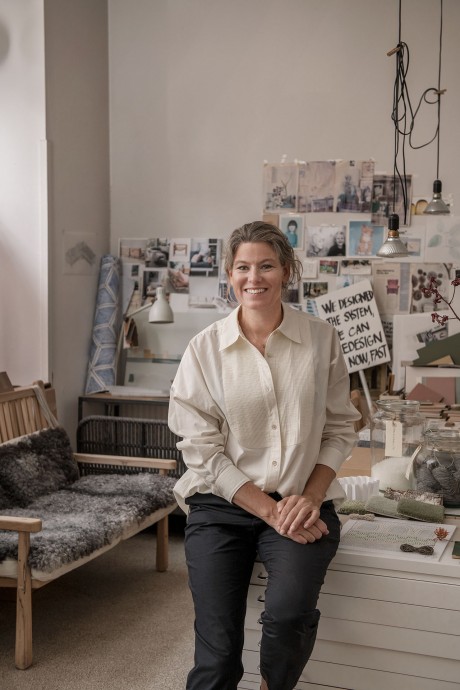Climate Warriors
A treehugging activist
For furniture designer Emma Olbers, climate goals and knowledge form the basis for credible sustainability efforts. The desire to influence is trans- lated through design jobs and activism, from well-considered material choices to Fridays for Future demonstrations. She speaks objectively about the need to tax carbon emissions and how designers do best in thinking backwards.What does sustainability mean to you in your position as a designer and in your company?
– The sustainability issue is huge and it’s important that we adhere to the Planetary Boundaries, a concept developed by researchers that addresses aspects like biological diversity and water. I’ve chosen to focus on the climate and especially the increasing temperatures. In order to lower the temperature, greenhouse gas emissions are of most
significance, which is measured in carbon dioxide equivalents, CO2e. In furniture production, the actual material accounts for about 50 per cent of emissions. That’s why I’m very keen to use mate- rials with low CO2e. We may be talking recycled materials, the amount of material and that the product can be recycled and maintained. That’s where I as a designer can make the biggest difference.
Why did you choose this path?
– I grew up in the fifth generation of farmers outside Gothenburg. Resource management was clear, it’s like we only have the farm on loan from our children. I learnt early on things like it takes time for a pine tree to grow. I studied at Nyckelviksskolan and Beckmans in the 1990s, and there wasn’t much talk about lifecycle analysis. My desire to work with those issues grew stronger after I had children and continued my studies in sustainable design. One of my first projects was Stockholm Wood 2007 where I made furniture out of wood that had grown in various places around town. Apart from low CO2e emissions, I was also interested in whether we take better care of our furniture emotionally if we know which trees they’re made of. I certainly believe we do. In the interior that I’m currently doing for the new Ersta Hospital, I’m using material from the trees that stood on the site before.
Which of your projects that represent sustainability and design are you most proud of?
– Different products are good for different things. For the tufted carpet
I made together with Asplund for the library at the newly renovated Natio- nalmuseum, we used a mix of wool and a new material called Tencel. It’s made of fast-growing woods and produced in a closed, environmentally friendly system. It makes less greenhouse gases than a lot of other textile alternatives. Which do you see as the biggest obstacles today for using design as a tool for societal transformation?
– That people’s awareness is too slow. Design is a good tool and a good problem solver, but time is against us. In a purely political sense, it would be good to put a price on carbon dioxide, so that products that are meant to protect our future are cheaper than products that destroy it. We only have
elections every four years, and demon- strating to spark public opinion is a powerful way of influencing political decisions.
How has the pandemic affected your work? Will you walk away with any new expe- rience and which challenges will you face moving forward?
– What’s amazed me the most is how we’ve listened to science and changed our behaviour so fast. That gives me hope, because it would be catastrophic if we just went back to the old normal. I hope that climate research will be higher on the agenda and that support for the big restart is done properly, like trains getting more subsidies than airlines. I also hope that that we’ve gained a new approach to concepts like
time and money. That we don’t rush off and start consuming, only to have ten umbrellas by the door that we can’t find. Which other countries do you think have come a long way with regards to sustai- nability and design? From where do you draw inspiration internationally?
– France and Paris are interesting at the moment. They’re working on a fifteen- minute rule, and aiming to design a new city without cars. Wherever you live, you shouldn’t have more than fifteen minutes to walk or cycle to school, shops or work. I personally like to listen to climate researcher Johan Rockström. Are there times when you have to compromise your ideas and visions versus limitations that may arise when it comes to sustainable strategies? Or cont- rarily, can the restrictions serve as a creative engine?
– It’s sometimes hard to find recycled materials and they may be a lot more expensive. It can also be difficult to convince companies to produce in countries that use renewable energy and where steel is made in an environmentally friendly manner. But for designers, challenges can be fun. It’s sometimes said that 80 per cent of the sustaina- bility part of a project happens at the drawing table. Choosing recycled mate- rials makes an enormous difference. As designers, we must think backwards, and start planning for how a product is to be maintained and recycled long before it’s even made.

